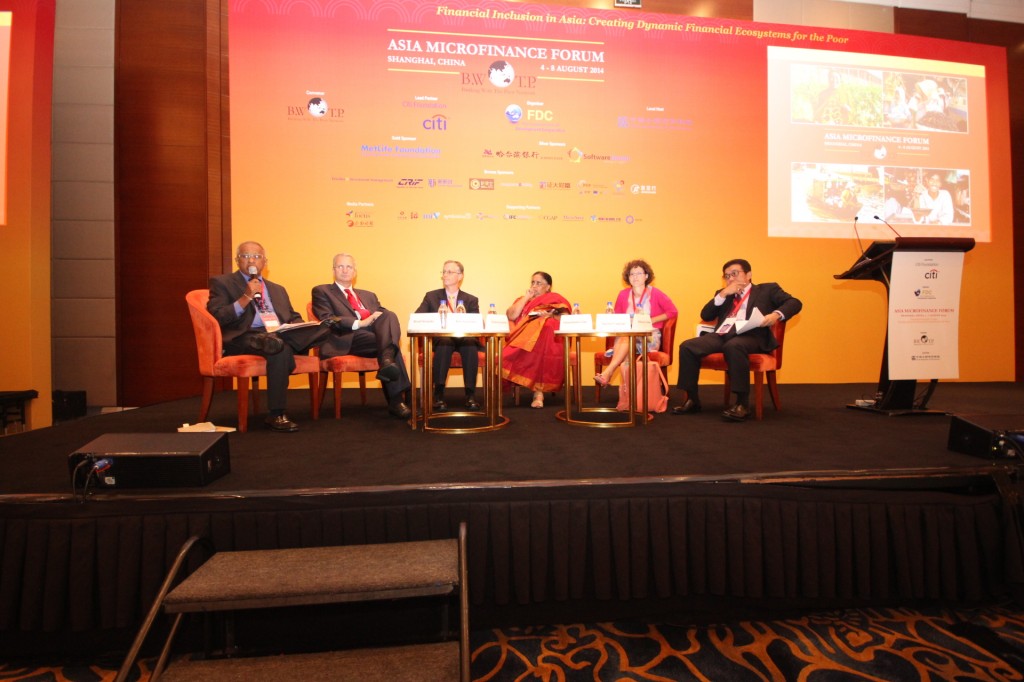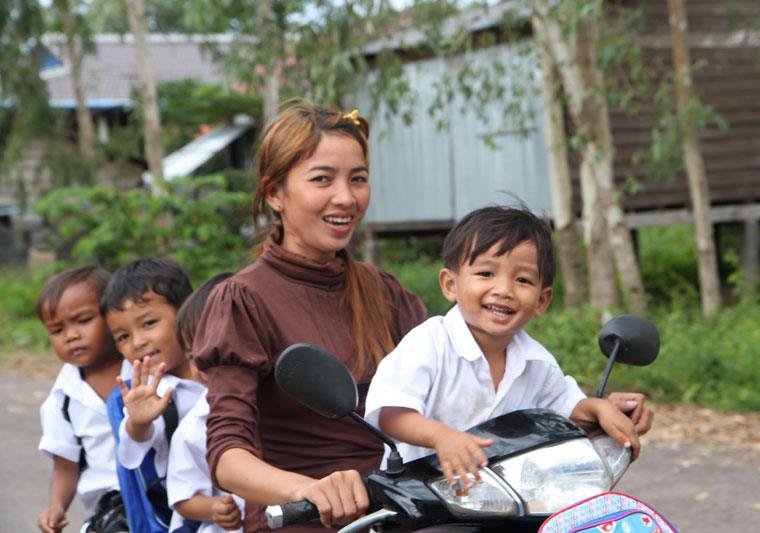The Paradigm Shift from Microfinance to Financial Inclusion
11:00 AM to 12:30 CST – The demand for greater financial inclusion is vast. Millions of people around the world are currently unable to access financial services, due to factors such as their cost, lack of access, and inadequate financial literacy and financial education. According to the World Bank sources, over 2.5 billion adults are estimated to lack access to formal financial services and a vast majority of low income people with access are under-served.
In 2006, the UN Publication, “Building Inclusive Financial Sectors for Development” noted that “we are in the midst of a paradigm shift from microfinance to inclusive finance.” Eight years have passed since then and the concept of financial inclusion has established itself firmly as a new paradigm in development finance. Over 50 developing countries are either implementing national financial inclusion strategies or in the process of developing such strategies, and central banks are playing a major role in efforts in developing and emerging economies.
At this plenary session, speakers discussed major issues related to this paradigm shift: What makes financial inclusion different from microfinance? What factors have led to a shift towards financial inclusion? How is improving financial inclusion expected to alleviate poverty and contribute to inclusive economic growth? The session also addressed how microfinance institutions and other financial service providers will be affected.
To begin the session, Mr Summerlin of the Pacific Financial Inclusion Programme discussed the shift from financial inclusion to microfinance.
“Microfinance and microcredit are but tools in a greater set of financial services that people need,” said Mr. Summerlin, noting there still hasn’t been an explosion of growth in microfinance institutions in the Pacific.
“Microfinance and microcredit are not the most perceived need,” said Summerlin of this deficit, noting that people in isolated areas of the Pacific may require other financial services before they require access to credit – credit being a hard thing for them to turn into tangible financial benefits for their household.
Meanwhile, Summerlin said that most people in the region may benefit more immediately from services such as usable savings accounts, insurance, improved remittances services, and better financial education. Summerlin stressed that opportunities exist to form partnerships in the Pacific between microfinance institutions and commercial interests, such as banks and insurance companies.
Rachel Freeman, IFC Manager for Access to Finance Advisory Services in East Asia, spoke next, explaining that while the IFC reaches 26 million, it is a “drop in the bucket” compared to the true world need.
“We need to think about how to reach those 2.5 billion – the hardest clients to get to,” said Freeman of the IFC’s efforts, which she feels will be accomplished via a combination of efforts from the public and private sectors.
“We believe financial inclusion has made us broader, bigger, smarter, and higher,” said Freeman, noting that without strong financial infrastructure, it will be difficult to move forward to reach the 2.5 billion. She also stated that reaching these people will involve working closely with governments and their institutions.
“Consumer protection and codes of conduct are part of our industry and weren’t before,” said Freeman, calling them “key aspects” which help them to serve clients and their needs better.
“We can achieve much more when we think about financial inclusion and all come into this ecosystem together,” said Freeman, noting the recent G-20 conversation on universal financial access – which means full usage of all products and services, not just access.
Mr. Muliaman D. Hadad, Chairman of the Financial Services Authority of Indonesia, which is the new regulator of formal financial institutions in the country, spoke next, addressing changes in the regulatory environment in Indonesia. Mr. Hadad addressed his authority’s role in supervising financial institutions and also furthering financial education – including customer protection, literacy and equal access.
“We have been dealing with microcredit for the past 30 years,” said Mr. Hadad of this progressive global change.”Now,” he continued, “it’s shifting because of financial inclusion, which is much more broad…we have to respond to this with a more appropriate strategy.”
Mr. Hadad noted that Indonesia has just launched a national strategy for microinsurance (which there is a large demand for), noting that this adheres to the world shift towards other kinds of financial products, not just small loans.
“We are very aware of earthquakes and floods because we live in the Ring of Fire,” said Mr. Hadad, referring to crop insurance and similar products as crucial financial inclusion. He also discussed the importance of technology in Indonesia’s financial sector, and how it can act as a “new platform for financial inclusion.”
Mr. Hadad also discussed how best to convince financial institutions that financial literacy and better consumer protections are relevant, noting that the focus must be professionally feasible – and that it is “not a charity program – it should be commercially viable and sustainable.”
“We have to convince banks that education is part of the investment, not an expense,” said M. Hadad. “If we start talking this language, bankers will start thinking.”
Next to speak was Mrs. Vijayalakshmi Das, the CEO of Ananya Finance for Inclusive Growth & Friends of Women’s World Banking, India.
Mrs. Das stated that “Inclusive Growth” is narrowly defined. While financial inclusion is critical for inclusive growth, it is important to create job opportunities for the poor to ensure sustainable livelihoods and enhance the level of productivity in the sectors the poor are engaged in. This would require access to technology and building affordable infrastructure they can access easily.
She emphasized that financial inclusion should lead to income and employment generation along with asset creation for the poor. It should not stop with just “rapid bank enrollment”.
Financial services for the poor must be understood from the demand side. The poor’s aspirations are growing, and as a result, they require loan and savings products to invest in education, healthcare and other safety nets.
Mrs. Das stated that low-income families spend more than 30% of their household income on education and healthcare. She expressed the need for creating infrastructure to help people address these persistent and large costs.
She stressed that small microfinance institutions are closer to the excluded population and can play an important role in financial inclusion. “Innovative and appropriate need based ideas often come from small institutions,” she said.
Mrs. Das was followed by Mr. Bob Annibale, Global Director of Citi Microfinance and Community, who discussed financial inclusion as a future objective. “Financial inclusion is a goal, it’s a policy objective, like universal education, world peace, or food security,” said Mr. Annibale. “These are goals, but it takes many many actors and states to get you there.”
Mr. Annibale discussed small SMEs that often work in areas where even the state does not manage to reach. “We put a request on them we don’t always put on ourselves – that they always be sustainable,” he said, explaining that these institutions may begin as philanthropic endeavors but can potentially grow into scalable and sustainable institutions after they meet immediate community needs.
Mr. Annibale stressed the importance of recognizing the spectrum of participants, while acknowledging the different strengths of each institution. Microfinance, said Annibale, addresses a certain segment in an educational and philanthropic way, a style that looks different when a commercial institution engages in it.
“Microfinance as a segment has an enormously important role and has created the foundation to be able to have these regulations,” said Annibale, citing the example of Indonesia’s RBI and its balance sheets resilience even in the face of financial meltdown, which “influenced millions of us around the world at institutions to think of what is possible, and what can be done with scale.”
Dr. Fernando noted in his closing remarks that financial inclusion is “not just about opening a savings or deposit account,” and that many of these accounts of poor and low-income people opened in response to new initiatives across most developing countries remain inactive. Hence, they do not contribute to effective financial inclusion.
“It is much more difficult than that,” he said, “and requires access, usage and quality financial services for which a wide range of providers, products and services are essential.”
“One of the fundamental changes with the paradigm shift is that regulators are now more in the picture – central banks are now very much involved in financial inclusion in a variety of ways,” Dr. Fernando said in closing.
It is important to note that the reinforced focus of the central banks on financial inclusion is partly due to the wide recognition of the nexus between financial inclusion and financial stability. Another factor is a better understanding of the connection between financial inclusion and inclusive economic growth.
Dr. Nimal Fernando, an associate at the Foundation for Development Cooperation, served as the session moderator. Dr Fernando was joined in the session by Mr Bob Annibale, Global Director of Citi Microfinance and Community, Mr Muliaman D. Hadad, the Chairman of the Financial Services Authority of Indonesia, Ms. Vijayalakshmi Das, the CEO of Ananya Finance for Inclusive Growth & Friends of Women’s World Banking, India, Mr Reuben Summerlin, Regional Financial Inclusion Advisor and Project Manager at the Pacific Financial Inclusion Programme (PFIP) and Ms. Rachel Freeman, IFC manager for Access to Finance Advisory Services in East Asia Pacific.
The session was facilitated by The Foundation for Development Cooperation, an independent Australian foundation that works to enable better development outcomes in the Asia-Pacific region.







Rural Banking and Credit, Poverty Alleviation Programs, Cooperative movement, Microfinance or Financial Inclusion cannot remain mere buzz words or jargon for the academics, researchers, policy makers, bankers or social workers. What the farming and rural community need is support be it in kind or cash. Government can help improve their quality of life only by affording infrastructural facilities like roads, safe drinking water, education, shelter, veterinary and medical facilities, employment opportunities and so on. Once these indexes are announced, action and implementation towards attaining of tangible results is essential. These reports, books, articles or research papers cannot merely be placed in racks and libraries. What has been the outcome of 12 Five Year Plans in India post independence in 1947? Whether the fate of the common man below poverty line has changed even marginally? Only the rich are becoming richer while the politicians and bureaucrats have been baking the policies which do not benefit the poorer sections. Twenty-first century world is modern and advanced in many directions – scientifically, economically and technologically. All these resources and inputs should culminate in tangible deliverables. It is a pity that the world leaders continue to indulge in racial discrimination, economic sanctions while terrorism and communal differences prevail all over. Welfare is always given a go-bye.